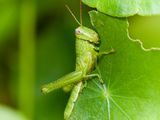What Is A Consumer That Eats Both Plants And Animals
On a sawgrass prairie in the Florida Everglades, an alligator (Alligator mississippiensis) lazes on the banking company of a slow-moving water channel. A great egret (Ardea alba) stalks fish in the shallows. A grasshopper (Brachystola magna) chews on an aster leaf. A raccoon (Procyon lotor) digs in the mud for freshwater mussels. These animals are quite different from one some other and live in different means, merely they have something in mutual: In this ecosystem, they are all consumers. Within every ecosystem, organisms interact to move energy around in predictable ways. These interactions tin can be represented by what scientists phone call a trophic pyramid. Primary producers—plants, algae, and bacteria—brand upwards the base of the pyramid, the first trophic level. Through a process called photosynthesis, producers capture energy from the sun and use it to create simple organic molecules, which they utilise for food. Consumers establish the upper trophic levels. Dissimilar producers, they cannot make their own food. To become free energy, they eat plants or other animals, while some eat both. Scientists distinguish between several kinds of consumers. Primary consumers brand upward the second trophic level. They are also chosen herbivores. They consume primary producers—plants or algae—and zero else. For example, a grasshopper living in the Everglades is a primary consumer. Some other examples of principal consumers are white-tailed deer that fodder on prairie grasses, and zooplankton that eat microscopic algae in the water. Next are the secondary consumers, which eat principal consumers. Secondary consumers are mostly carnivores, from the Latin words pregnant "meat eater." In the Everglades, egrets and alligators are carnivores. They consume only other animals. Most carnivores, called predators, chase and impale other animals, but not all carnivores are predators. Some, known every bit scavengers, feed on animals that are already expressionless. Some consumers feed on alive animals but do not kill them. For instance, small arachnids called ticks attach themselves to other animals and feed on their blood, simply ticks are not considered predators. They are instead called parasites. Some secondary consumers eat both plants and animals. They are called omnivores, from the Latin words that mean "eats everything." A raccoon is an instance of an omnivore; it eats plant matter such as berries and acorns, but information technology also catches crayfish, frogs, fish, and other pocket-sized animals. Ecosystems tin can as well accept 3rd consumers, carnivores that consume other carnivores. A bald eagle is an example of a tertiary consumer you might see nigh the littoral mangrove islands of the Everglades. Its diet includes predatory fish that eat algae-eating fish, as well as snakes that feed on grass-eating marsh rabbits. Information technology is considered a "top predator" because no other animals native to the ecosystem hunt or eat it. When a top predator dies, information technology is consumed by scavengers or decomposers. In addition to consumers and the producers that support them, ecosystems have decomposers. These organisms get their nourishment from dead organic material, such equally decomposable institute leaves or dead fish that sink to the lesser of a pond.

Grasshoppers are primary consumers because they eat plants, which are producers. Producers are the base of the pyramid, the first trophic level.
Photograph past mchin
algae
Plural Substantive
(singular: alga) diverse group of aquatic organisms, the largest of which are seaweeds.
Plural Noun
(singular: bacterium) unmarried-celled organisms found in every ecosystem on Earth.
Noun
organism that eats meat.
consumer
Noun
organism on the food chain that depends on autotrophs (producers) or other consumers for food, diet, and energy.
decomposer
Noun
organism that breaks down dead organic material; likewise sometimes referred to as detritivores
Noun
customs and interactions of living and nonliving things in an expanse.
Everglades
Substantive
vast swampy region flowing s of Lake Okeechobee in Florida.
Substantive
grouping of organisms linked in order of the nutrient they eat, from producers to consumers, and from prey, predators, scavengers, and decomposers.
Noun
all related food chains in an ecosystem. Also called a food cycle.
Substantive
organism that eats mainly plants and other producers.
molecule
Noun
smallest concrete unit of a substance, consisting of 2 or more atoms linked together.
Noun
organism that eats a diversity of organisms, including plants, animals, and fungi.
parasite
Noun
organism that lives and feeds on another organism.
Noun
process by which plants turn water, sunlight, and carbon dioxide into h2o, oxygen, and simple sugars.
predator
Noun
beast that hunts other animals for food.
producer
Noun
organism on the nutrient chain that can produce its own free energy and nutrients. Besides called an autotroph.
slough
Noun
marshy wetland largely defined by thick mud.
trophic level
Substantive
one of iii positions on the food chain: autotrophs (first), herbivores (second), and carnivores and omnivores (tertiary).
Source: https://www.nationalgeographic.org/encyclopedia/consumers/
Posted by: ornelasproffecanded.blogspot.com

0 Response to "What Is A Consumer That Eats Both Plants And Animals"
Post a Comment